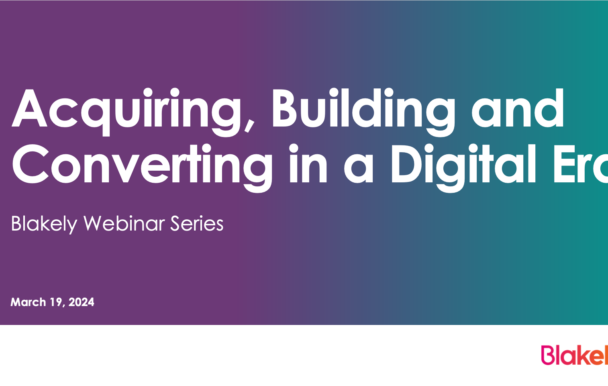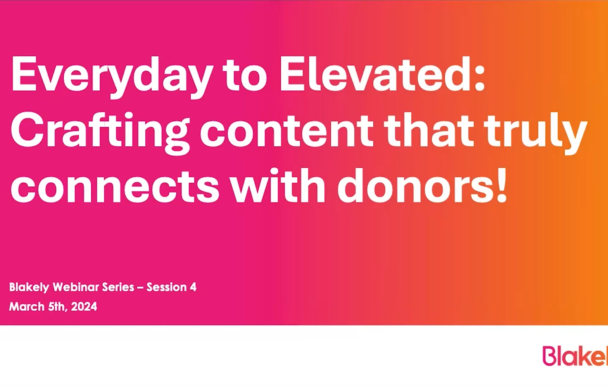Making The Case For Agility in Legacy Marketing
I have never experienced a more important time for major investments in legacy giving than right now. During my career, both in corporate marketing and in fundraising, I have always had one eye on the long game. But 2020 is a definite reminder that revenue diversification is key to our survival, and for those who have already been investing in legacy during the past 5 to 8 years, this global pandemic has solidified donors’ relationships (or not) with our charities and allowed us to continue to be relevant with our most passionate supporters.
The one thing about isolation and lockdown is that people’s comfort and use of digital channels has exploded – driving a majority of the giving and engagement. But how has your legacy marketing adjusted? Are you doing everything you can to engage current supporters and brand new people? Are you waiting for everything to be tried and true and tied up with a bow? Hopefully not!
If you only focus on two things – these are what they should be:
Using digital channels to our advantage in legacy starts with our own assets and with the understanding of their power. It’s recognizing the incredible opportunities that exist in building connections right from the get-go and creating exciting and personalized donor journeys that deliver the right content to all of our key groups – expectancies, hand-raisers and prospects.
We are using email to support and steward donors and deliver to them the specific content they need and want by audience. Because of that, they are engaging, and we are staying relevant and even connecting with new people – happy days. Legacy marketers are seeing some pretty exciting things happen as our donor groups change, and we change with them in order to meet them exactly where they are on the journey with our organizations.
Website
Often, as many as 60% of our actual legacy gifts are from people we don’t know or who are not on the radar – so that makes our web sites even more important. If you can improve that experience, can you imagine what might be possible in the future?
Not all investments in smart, strategic legacy marketing are expensive. In fact, the most important marketing tool is your very own – it’s your web site. No one reaches out before they do their homework – and that goes for current donors and people whose attention you catch because of your cause, your great content or your ongoing marketing (all of which are key to staying connected during COVID-19, regardless whether you are front line or not).
Use your legacy page (which, hopefully, is easy to find and easy to navigate) to demonstrate caring and a human touch. Be inspirational and demonstrate to people the impact they will have with a gift in the future. Implement best practices on it – include your picture and your own details as a legacy fundraiser. Make people want to connect by being agile and pivoting when needed. Not on your mission, which is at your core, but on your messaging and your content, and the channels you are using to connect.
Remember – your web site is NOT STATIC!
It’s not a printed brochure for which you have 20,000 sitting in inventory that needs to be used up. It’s there for you to change – constantly – and if you have barriers to making that happen – get them removed, now.
It sounds simple, so why are we not doing it?
Stephen George – of Good Leaders, in the UK – and I looked at over 100 Canadian, US, and UK charity web sites, just to see who had changed up their language on the legacy page during the global pandemic.
There were two. Wow. Two organizations realized that a) people were struggling and wanted to live their missions and demonstrate caring at this tremendously difficult time, and b) people were making decisions about wills at unprecedented rates and were looking at the web pages of the charities of their choice, for inspiration. Pretty simple right? Apparently not – so a shout out to Deborah Bauder and the team at Oakville Hospital Foundation in Ontario, Canada for recognizing it and taking action by being human and staying relevant.
When I was driving legacy giving at a small social service organization, on its web site I included my picture; why the organization mattered to me; and a drop-down contact form which made it easy for anyone to reach out. Almost every one of my conversations with a person making an inquiry started with them referencing my passions. It was a bridge to conversation.
You are asking people to reach out to a total stranger and talk about their personal legacy and estate. Therefore, you must make the experience as human as possible.
My challenge to every fundraiser…
So, I’m going to challenge you to make changes to your legacy web pages so often, that the Mar/Comm team (or whatever part of your organization is responsible for managing the web site that is there to support the revenue areas) complains about you! Then, you will know that you are relevant to any donor who is looking for information today and possibly checking to make sure their original decision is still a solid one. Especially as the global pandemic continues.
Legacy giving already leads in delivering amazing lifetime value, ROI, and a focus on relationships, so why not have it lead on an agile approach to communications and be willing to do things differently to drive connection? I think your donors will love it.








